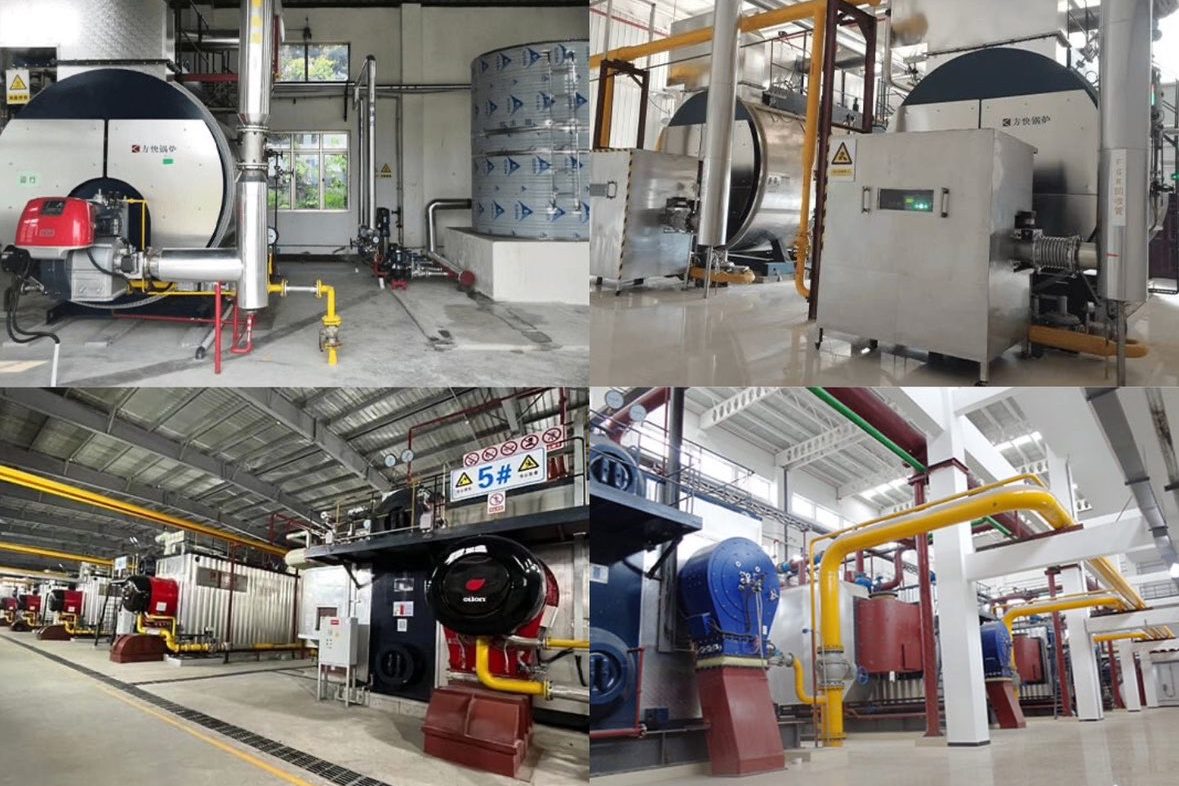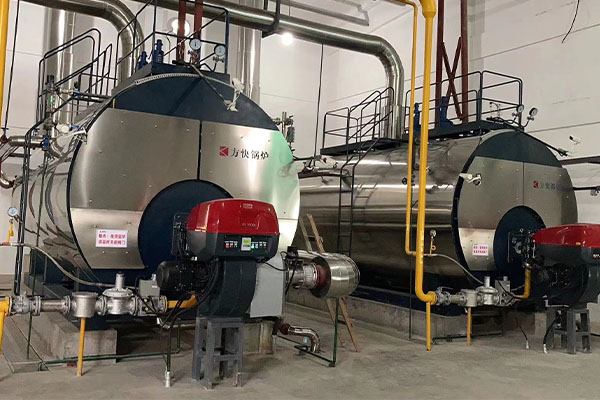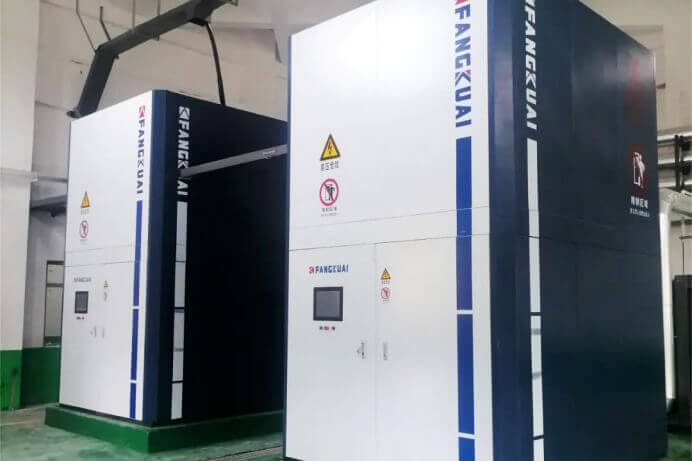Industrial boilers are high-capacity, ASME-certified pressure vessels designed to convert water into steam or hot water at controlled pressure and temperature. The fuel (natural gas, oil, coal, or biomass) releases thermal energy. This heats the medium to high temperatures and pressures, producing steam or hot water, which is then piped to industrial processes such as power generation, chemical synthesis, food processing, and large-scale HVAC systems, thereby converting and utilizing the energy.

Industrial Boiler Structure
- Furnace or Combustion Chamber – where fuel is burned to release heat.
- Heat‐Exchange Surfaces – typically a network of tubes (fire-tubes or water-tubes) that transfer heat from combustion gases to feedwater.
- Steam Drum & Mud Drum (in water-tube designs) – the drum separates steam from water and collects impurities.
- Burner & Fuel‐Supply System – controls fuel flow and combustion air for efficient firing.
- Feedwater & Blowdown Systems – maintain proper water chemistry and remove sludge or scale.
- Controls & Safety Devices – pressure-sensing switches, safety relief valves, and automated controls ensure safe, stable operation.
In operation, feedwater is pumped into the boiler where it absorbs heat through the tubes. As the temperature and pressure rise, water flashes into steam, which is then separated and routed to process equipment. Spent flue gases exit through a stack or economizer, occasionally preheating incoming feedwater to boost overall efficiency.
Main Types of Industrial Boilers
Industrial boilers are primarily categorized by how they transfer heat and by their application:
A. Water-Tube Boilers

- Design: Water flows inside tubes heated externally by combustion gases.
- Subtypes:
- D-Type & O-Type: Vertical drum arrangements minimizing water volume for rapid startup.
- Once-Through Boilers: No steam drum; water superheats in a single pass.
- Advantages:
- High pressure/temperature capability (hundreds of barg/°C).
- Rapid response to load changes.
- Compact footprint for given capacity.
B. Fire-Tube Boilers

- Design: Combustion gases travel through tubes submerged in a water-filled shell.
- Common Models:
- Scotch Marine Boiler (multi-pass, compact).
- Horizontal Return Tubular (HRT) for moderate pressures.
- Advantages:
- Simpler construction and lower capital cost.
- Easier maintenance for small- to mid-capacity needs.
C. Specialty Boilers

- Thermal Oil (Hot-Oil) Boilers: Circulate heated oil to 300 – 400 °C without high pressure, ideal for chemical or drying processes.
- Waste‐Heat Recovery Boilers: Capture residual heat from engines, furnaces, or kilns to generate steam, improving overall plant efficiency.
- Electric Boilers: Use resistive or electrode heating for emission-free steam where electricity is economical or emissions are restricted.
Fuel Options: Cost, Availability & Emissions
Fuel choice impacts boiler design, operating cost, and environmental compliance. Common fuels include:
- Natural Gas & LPG
- Pros: High energy density, clean combustion, precise modulation.
- Use: Dominant in regions with established gas networks.
- Fuel Oil (No. 2, No. 6)
- Pros: Stable pricing in some markets, reliable storage on‐site.
- Cons: Higher SOx/NOx emissions without treatment.
- Coal & Biomass
- Pros: Low fuel cost where feedstock is abundant (e.g., agricultural residue).
- Cons: Requires specialized handling, ash removal, and emissions controls.
- Electricity
- Pros: Zero on‐site emissions; simple operation.
- Cons: High operating cost unless off-peak or renewable tariffs apply.
- Dual-Fuel Systems
- Many industrial boilers incorporate dual-fuel burners, automatically switching between gas and oil to hedge fuel‐price volatility.
Selecting the optimal fuel involves balancing fuel cost, combustion efficiency, and regulatory requirements (e.g., NOx/SOx limits, carbon pricing).
Industrial vs. Commercial Boilers: Key Distinctions

Though both types produce steam or hot water, industrial and commercial boilers differ substantially in scale, design, and regulation:
| Attribute | Industrial Boilers | Commercial Boilers |
|---|---|---|
| Capacity | Up to hundreds of MMBtu/hr or hundreds of MW | Typically < 500 kW or few MMBtu/hr |
| Operating Pressure | From low pressure up to 200+ barg | Usually < 5 barg |
| Construction | Heavy-gauge steel, welded headers, modular skid packages for parallel operation | Lighter construction, compact wall-hung or floor-standing units |
| Control & Safety | Advanced PLC/DCS integration, multi‐level redundancy | Simpler thermostat and pressure‐switch controls |
| Regulatory Compliance | Stringent emissions (BREF, EPA), blowdown recovery requirements | Standard commercial emissions and building codes |
| Maintenance Intervals | 8,000–20,000 hr runtimes between major shut-downs | 4,000–8,000 hr due to smaller size and simpler design |
Industrial boilers must ensure continuous uptime under harsh loads, whereas commercial units prioritize cost-effective heating and hot-water delivery for buildings.
The Pinnacle of Steam Efficiency: Condensing & Beyond

Achieving maximum thermal efficiency requires recovering as much heat as possible from combustion products. Key strategies include:
- Condensing Boilers
- Utilize a secondary heat exchanger to condense water vapor in flue gases, capturing latent heat.
- Efficiency Range: 90 – 99 % AFUE, depending on return-water temperature and load modulation; top-end models approach 98 – 99 % under optimal conditions.
- Oxygen Trim & Modulating Burners
- Continuously adjust air-fuel ratio to maintain near-stoichiometric combustion across loads, reducing stack losses.
- Economizers & Feedwater Heaters
- Preheat incoming water using flue-gas heat, reducing fuel needed for steam generation.
- Waste-Heat Recovery
- Integrate with process exhaust (kilns, engines) to reclaim high-grade heat without additional fuel input.
- Flexible Operation & Load Matching
- Modular boiler systems (e.g., Miura’s LX Series) allow individual units to fire only as needed, maintaining high part-load efficiency and reducing cycling losses.
Together, these innovations push industrial steam-generation efficiency toward the theoretical maximum dictated by the Carnot cycle and real‐world constraints, enabling facilities to lower both operating costs and greenhouse-gas footprints.
Get your best price
Quickly compare 3 FREE quotes
- Engineer quick quote
- The overall delivery speed is fast
- Financial choice
- Low installation costs and cost savings
25 years+ of boiler R&D
More than 20 innovative technologies
